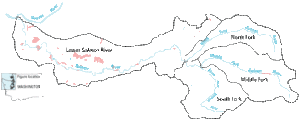Salmon River (Washington) facts for kids
Quick facts for kids Salmon River |
|
|---|---|
| Country | United States |
| State | Washington |
| County | Jefferson |
| Physical characteristics | |
| Main source | Olympic Mountains 47°31′27″N 124°2′29″W / 47.52417°N 124.04139°W |
| River mouth | Queets River 47°33′21″N 124°13′12″W / 47.55583°N 124.22000°W |
| Length | 18 mi (29 km) |
| Basin features | |
| Basin size | 56 sq mi (150 km2) |
The Salmon River is a river in the United States. It flows through the state of Washington. This river is a tributary, which means it's a smaller river that flows into a larger one. The Salmon River joins the Queets River.
The Salmon River starts in the Olympic Mountains. It flows generally from east to south. Several smaller streams, called forks, come together to form the main river. These include the North Fork, Middle Fork, and South Fork Salmon River. The river then flows into the Queets River.
The Salmon River, including its longest fork (the Middle Fork), is about 18 miles (29 km) long. The main part of the Salmon River, after the North Fork joins, is about 13 miles (21 km) long. The total area of land that drains water into the Salmon River, called its drainage basin, is about 56 square miles (150 km2).
River Rocks and Land
The land around the North, Middle, and South Forks of the Salmon River is made of shale and sandstone. These are both types of sedimentary rock, which form from layers of sand and mud over a long time.
Closer to where the Salmon River meets the Queets River, the land is different. It's made of loose materials like gravel, sand, silt, and clay. These materials were left behind by ancient glaciers from the Olympic Mountains.
Animals and Plants of the River
More than 80% of the land around the Salmon River is covered by coniferous forests. These forests have trees like Sitka spruce, Western hemlock, and Douglas fir. The rest of the area has other types of trees or wetlands, which are areas of land covered by water.
Fish in the River
The Salmon River is home to several types of fish, especially salmon. There is a special place called a fish hatchery on the river. A hatchery is like a farm for fish, where they are raised from eggs. This hatchery helps to breed Coho salmon and Chinook salmon.
Young Rainbow trout called "Winter steelhead smolts" are also released into the river each year from the hatchery. Other fish that live in the river include Coastal cutthroat trout and more Chinook salmon.


